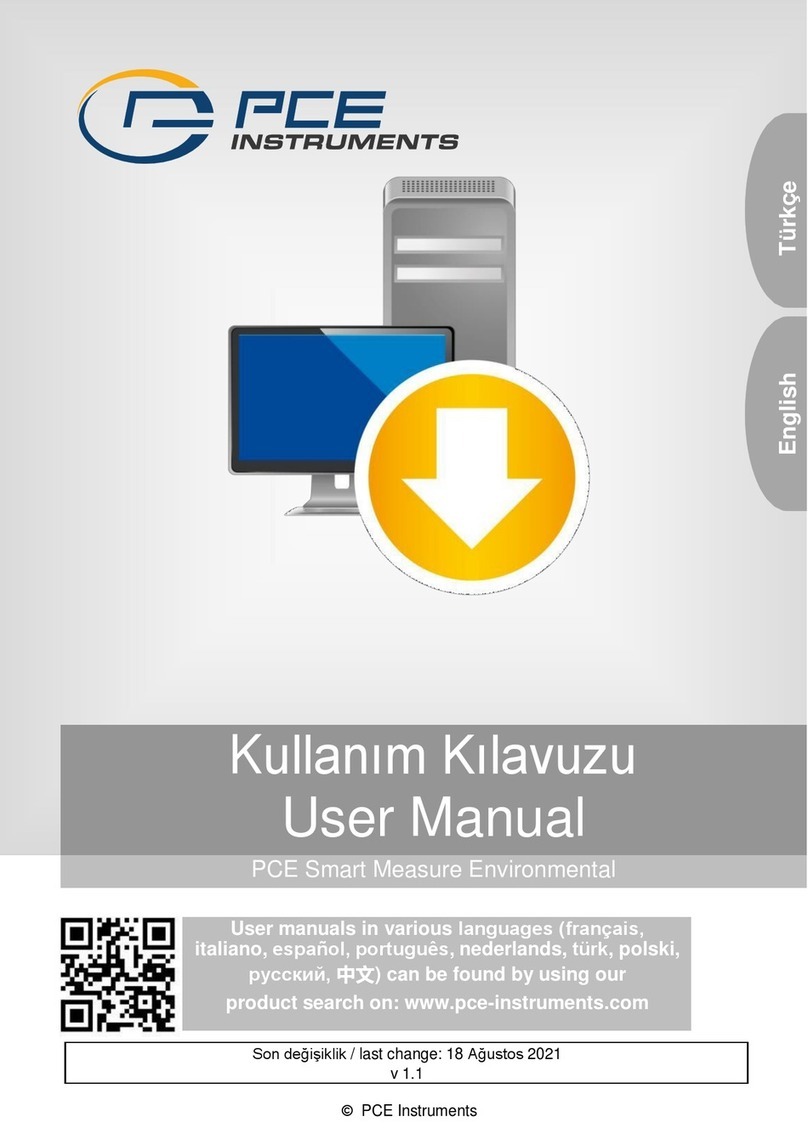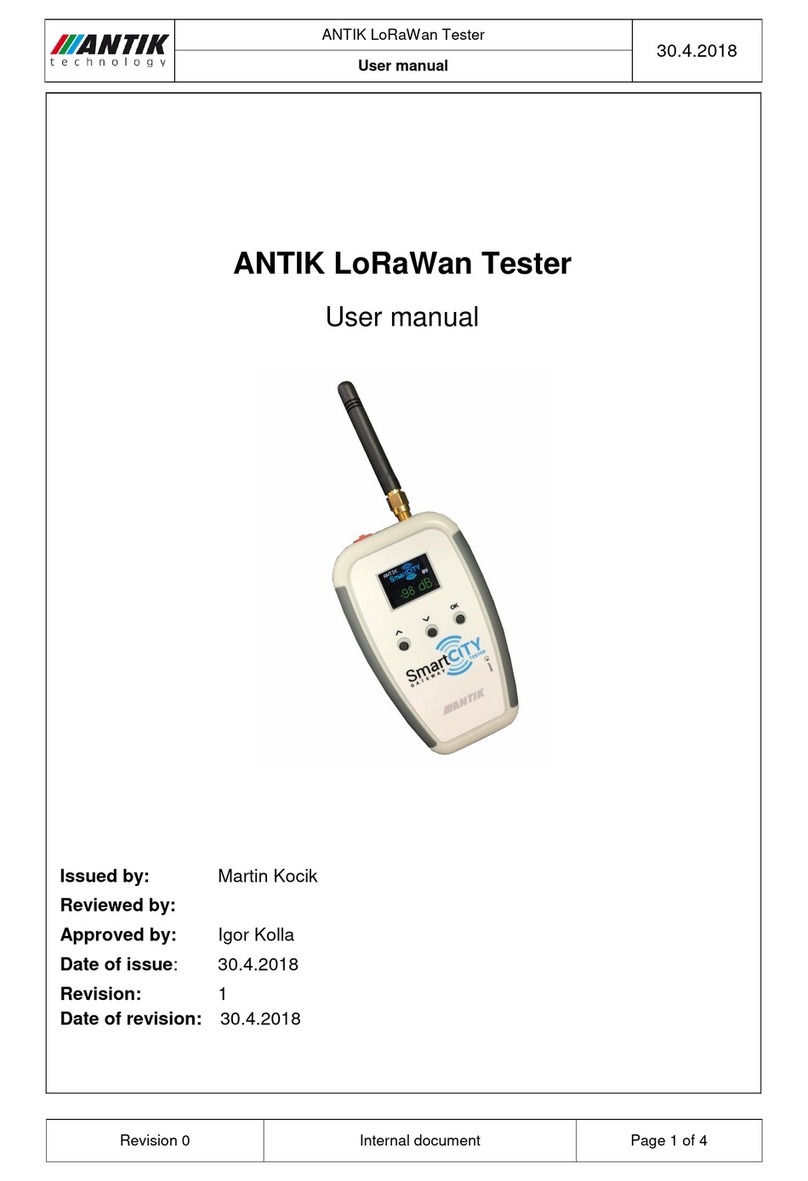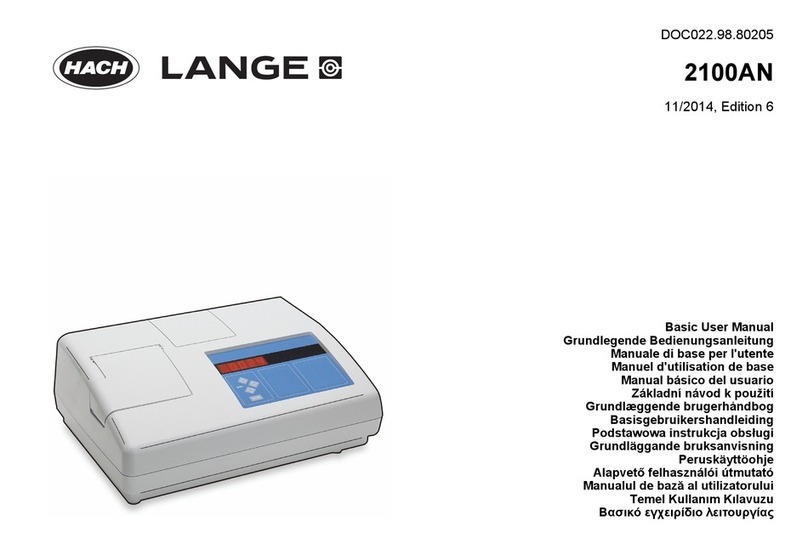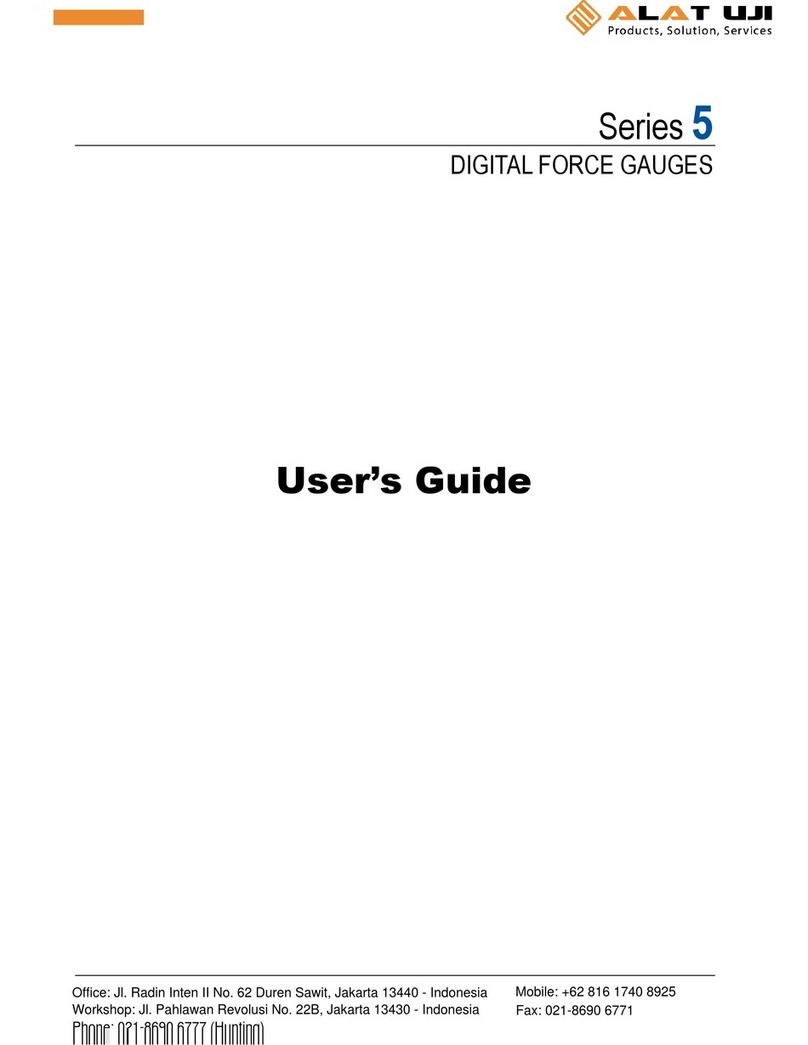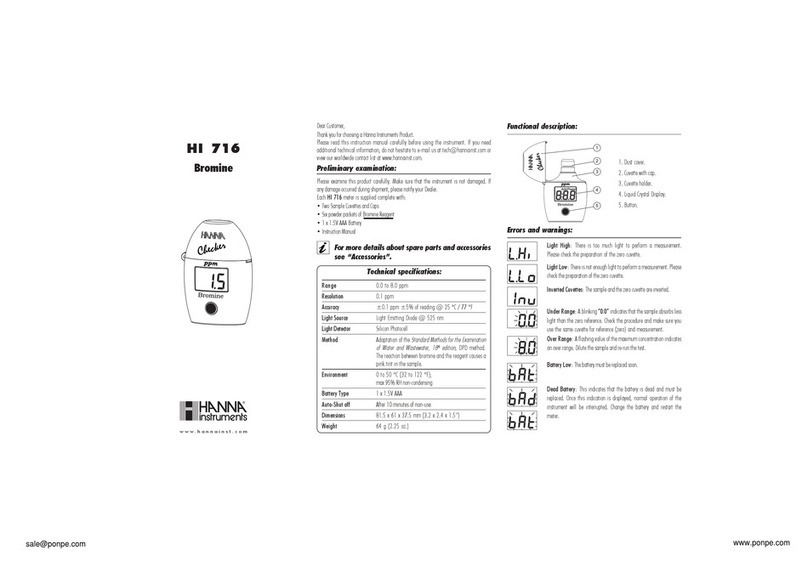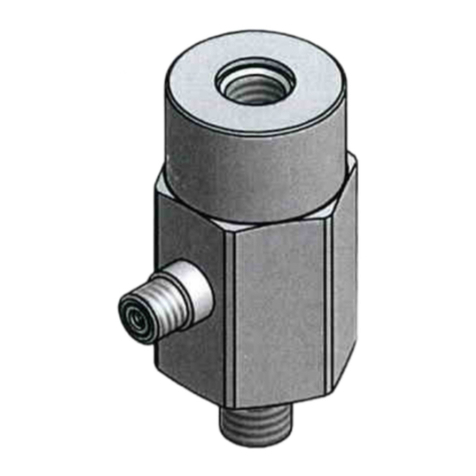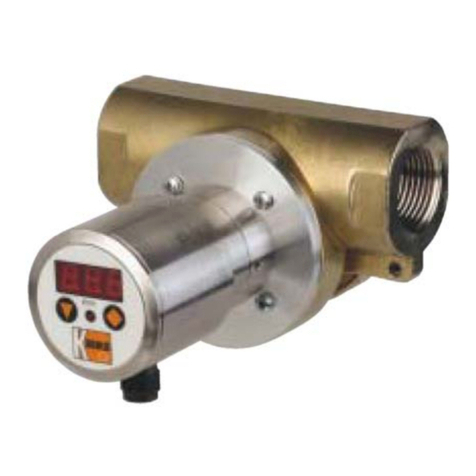FIEDLER H531 User manual

+
Level measurement in
wells, boreholes,
tanks and sumps
Level gauge H531
user manual version 1.03

H531 level gauge assembly
User manual
2
electronics for ecology
FIEDLE R

H531 level gauge assembly
User manual
FIEDLE R electronics for ecology
3
1. SAFETY INSTRUCTIONS 4
2. USING THE LEVEL GAUGE 5
3. QUICK INSTALLATION OF THE LEVEL GAUGE 6
3.1.1. INSTALLING THE LEVEL SENSOR 6
3.1.2. INSTALLATION OF THE DISPLAY UNIT 7
4. BASIC DESCRIPTION 8
4.1. LEVEL SENSORS 8
4.1.1. ABSOLUTE LEVEL SENSOR 9
4.1.2. PRESSURE COMPENSATED LEVEL SENSORS 10
4.2. H531 IMAGING UNIT 12
4.2.1. DESCRIPTION OF H531 CONTROLS AND CONNECTIONS 12
4.2.2. POWER SUPPLY FOR THE LEVEL GAUGE 13
4.2.3. DESCRIPTION OF TERMINALS AND CONFIGURATION JUMPERS OF THE H531 UNIT 14
5. INSTALLATION 15
5.1. MECHANICAL INSTALLATION 15
5.1.1. INSTALLATION OF THE TSH27 ABSOLUTE LEVEL SENSOR 15
5.1.2. INSTALLATION OF A PRESSURE COMPENSATED LEVEL SENSOR 16
5.1.3. EXTENSION OF THE CONNECTING CABLE 16
5.1.4. INSTALLATION OF THE H531 DISPLAY UNIT 17
5.2. ELECTRICAL WIRING 18
5.2.1. CONNECTING THE LEVEL SENSOR TO THE H531 UNIT 18
5.2.2. CONNECTING AN EXTERNAL POWER SUPPLY TO THE H531 19
5.2.3. CONNECTING A RELAY OR OTHER POWER ELEMENT TO H531 20
6. PARAMETERS 21
6.1. H531 LEVEL GAUGE PARAMETERS 21
6.1.1. PARAMETER DISPLAY 21
6.1.2. STRUCTURE OF THE H531 MENU 22
6.2. PARAMETER EDITING PROCEDURE 23
6.3. BASIC FACTORY SETTINGS OF THE H531 LEVEL GAUGE 25
6.4. DESCRIPTION OF INDIVIDUAL H531 PARAMETERS 26
7. REMOTE ACCESS 40
7.1. ARCHITECTURE OF THE DATA ACQUISITION SYSTEM 41
7.1.1. ACTIVE STATION SYSTEM 41
7.1.2. DATA SERVICES 41
7.1.3. CLOUD SERVICES 41
7.1.4. DATAHOSTING AGGREGATE SERVICE 41
7.2. LEVEL GAUGE H531-G 42
7.2.1. GSM/GPRS TECHNOLOGIES 42
7.2.2. ANTENNA 42
7.2.3. PARAMETERS OF THE H531-G LEVEL GAUGE 43
8. TECHNICAL PARAMETERS 44
CONTE
NTS

H531 level gauge assembly
User manual
4
electronics for ecology
FIEDLE R
1. Safety instructions
•The installation of a level gauge with external power supply must be carried
out by a person with the necessary qualifications for the installation of elec-
trical equipment. The installer must carry out the installation in accordance
with all instructions, regulations and standards relating to safety and electro-
magnetic compatibility.
•If a malfunction of the level gauge could result in a risk to the safety or health
of persons or serious damage to property, independent measures must be
taken or additional equipment installed to eliminate this risk.
•All connected downstream equipment must comply with the relevant stand-
ards and safety regulations and be equipped with suitable anti-interference
filters and surge protection.
•Do not use in explosion hazardous areas!
•Do not use in areas of excessive vibration.
•The manufacturer is not liable for damages resulting from improper instal-
lation, improper maintenance or use contrary to the recommendations in
the operating instructions.
!
If an external power supply is used, it must meet all safety standards and be
appropriate for the environment in which it will be operated.
!
Connect the binary transistor output for switching a relay, solenoid valve or
light or sound signal only when the supply voltage is disconnected.
!
When installing a submersible level sensor, make sure that the maximum
measuring range of the sensor is not exceeded even at the maximum possi-
ble water level.
1

H531 level gauge assembly
User manual
FIEDLE R electronics for ecology
5
2. Using the level gauge H531
The battery-powered H531 level gauge assembly consists of the H531 display
unit itself and a submersible level sensor. The assembly is designed for level
measurement in rainwater tanks, cisterns and tanks, wells or boreholes.
The assembly can be used wherever the measuring range and accuracy of the
type of sensor used is suitable and where long-term archiving of the measured
values is not required (the H531 unit does not provide a datalogger function).
The H531 level gauge also includes a binary output controlled by the actual
measured level and therefore the level gauge assembly can be used, in addition
to displaying the level, for simple control of a pump or solenoid valve based on
user adjustable parameters.
The measured level height can be transmitted via the internal communication
module to the database on the server via GSM/GPRS or NB-IoT network (H531-
G or H531-N level gauges). The user can then monitor the level remotely via a
web browser. A special server service can also ensure that a warning SMS is sent
when a preset level is reached.
The mechanical design of the H531 display unit with IP66 protection allows the
unit to be placed outdoors directly at a well or rainwater sump. In this case, it is
advisable to avoid direct sunlight on the H531 display unit to prolong the life of
the unit, as UV radiation can cause the plastic materials used to become brittle.
TYPICAL APPLICATIONS
•Monitoring water levels in wells and boreholes
•Monitoring the level in stormwater sumps
•Automatic water supply to the tank
•Blocking the pump in the well from running on empty
•Indication of reaching limit levels
2
B i n a r y o ut pu t
R e m o te a c c e s s
L o c a t i o n

H531 level gauge assembly
User manual
6
electronics for ecology
FIEDLE R
3. Quick installation of the H531
3.1.1. Installing the level sensor
From the factory, the level gauge is assembled and set so that when the sensor
is lowered into the measured sump/mud/tank, the H531 display shows the
measured water level above the sensor. The measuring range of the level gauge
is determined by the type of sensor used (0 to 10 m, 0 to 25 m).
For a sensor with a measuring range of 0 to 10 mH2O, without further adjust-
ment of the H531 parameters, the display will also show a level height in the
range of 0 to 10 m, depending on the depth of immersion of the sensor below
the measured water level.
If the level gauge is to indicate the level from the bottom of the measured
sump/cold and the measuring range of the sensor used is greater than or equal
to the maximum possible level in the measured sump/cold, then it is sufficient
to lower the level gauge to the bottom.
In these first two cases, the user does not need to make any changes to the
parameter settings when installing the level gauge.
Measurement by immersion depth Level measurement from the bottom
Param. Delta
3
L e v e l
m e a s u r e m e n t b y
i m m er s i o n d e p t h
L e v e l
m e a s u r e m e n t f r o m
t h e b ot t o m

H531 level gauge assembly
User manual
FIEDLE R electronics for ecology
7
If the level gauge is to display the level from the bottom even if the measuring
range of the sensor used is less than the maximum possible level in the meas-
ured sump/well (third case in the previous figure), then it is necessary to correct
the measured level with the Delta parameter. The numerical value of this pa-
rameter will be permanently added to the measured level height in the H531
unit. It is clear from the principle that the displayed level height will never fall
below the value of the Delta parameter in this case.
The approach to the Delta parameter is given in chap. 3-4-3 Delta on p. 31.
3.1.2. Installing the display unit
The H531 display unit is usually placed close to the measured level. The maxi-
mum possible distance between the submerged transducer and the display unit
is determined by the length of the connection cable between the transducer
and the unit.
If it is necessary to place the display unit
at a greater distance from the measured
sump/cell, then the connection cable can
be extended (see chap. 5.1.3 Extension of
the connection cable on p. 16), or order
an extra length of jumper cable from the
level meter manufacturer.
The mechanical design of the imaging unit
allows it to be placed outdoors, it is only
necessary to protect the unit with a suita-
ble cover from direct sunlight to prevent
gradual degradation of the plastic imag-
ing panel due to UV radiation.
The display unit is factory set to a power
saving display mode, in which the unit's
display wakes up only for a short time af-
ter pressing one of the unit's control but-
tons. The unit is powered by an internal
lithium battery in this mode.
If the level gauge is to be operated in the
mode with permanently switched on dis-
play of the measured level, then it is nec-
essary to connect to the H531 display unit
a source of external power supply voltage of 5 to 28 VDC (see chap. 5.2.2 on p.
19).
The installation of the level gauge is covered in more detail in the chapter 5.
Installation on p. 15.
The installation and commissioning of the level gauges with the H531-G
or H531-N communication module is described in chapter 7-Remote access on
p. 40.
L e v e l co r r e c t i o n
b y D E LTA
p a r a m e t e r
C o v e r ag e f r o m
s u n l i g h t
P ow er s u p p l y a n d
o p e r at i n g m o d e

H531 level gauge assembly
User manual
8
electronics for ecology
FIEDLE R
4. Basic description
4.1. Level sensors
The submersible transducer converts the pressure applied to the
diaphragm by the transducer into an electrical signal measurable
by the H531 using a strain gauge sensor.
According to the type of measuring sensor used, strain gauge
sensors are divided into:
-absolute sensors
-pressure compensated sensors
The principle of measuring both types of sensors is explained in the following
two chapters.
Absolute sensors do not require a special cable with a compensation capillary
and therefore usually have a lower purchase price. On the other hand, they re-
quire more complex processing of their output signal in the connected display
unit.
The H531 can work with both types of sensors.
The level sensor is usually suspended by a cable above the bottom of the sump,
well or borehole being monitored. However, in some cases, instead of submerg-
ing the sensor in the monitored environment, it may be advantageous to screw
the sensor into a ½" sleeve located at the bottom of the vessel or sump being
measured.
Each level sensor includes a cable that suspends the sensor and connects it to
the H531 display unit. Since the cable is an integral part of the sensor, the length
of the cable along with the measurement range of the sensor must be specified
when ordering the sensor.
The connection cable is used both for powering the sensor's own electronics
and for transmitting the measured signal from the sensor to the H531 unit.
Pressure compensated sensors require a special cable with a compensation ca-
pillary. Therefore, the purchase price of such a sensor is usually higher than that
of an absolute sensor. This is especially true for sensors installed in deep bore-
holes, which require a long connection cable.
4
S e n s o r di v i s i o n
S e n s o r l oc a t i o n
S e n s o r ca b l e
C a bl e p r i c e b y
s e n s o r t yp e
TSH27 ab-
solute le-
vel sensor

H531 level gauge assembly
User manual
FIEDLE R electronics for ecology
9
TSH27 absolute sensor
(without sensor cap)
4.1.1. Absolute level sensor
These sensors use an absolute pressure sensor to measure the water level,
which measures the hydrostatic pressure of the water above the sensor (h) in-
cluding the atmospheric air pressure (atm) and converts the resulting total pres-
sure to an output voltage signal in the range of 0 to 5 V.
The principle of level measurement with an absolute level sensor
In the H531 evaluation and display unit, the atmospheric air pressure separately
measured by the H531 is automatically subtracted from the sensor output sig-
nal. The resulting value, corresponding to the height of the water level above
the sensor, is converted to a numerical value displayed on the H531 LCD.
The absolute pressure measurement principle used allows the sensor to be con-
nected to the H531 level gauge via a standard 3-core cable without the usual
atmospheric pressure compensation capillary. A standard cable without a com-
pensation capillary is easier to handle, can be easily extended if necessary and
is also significantly cheaper than a cable containing a compensation capillary.
ABSOLUTE LEVEL SENSOR TSH27-X/Y (0-5 V output)
The TSH27 is an inexpensive absolute level sensor that does not require a special
cable with compensating capillary. The sensor has a stainless steel body with a
diameter of 27 mm and is 115 mm high including the sensor cap. By unscrewing
this cap, the sensor can also be installed in a ½" sleeve.
TSH27 sensors are available in two measuring ranges:
•TSH27-10/10 or TSH27-10/25
(measuring range 0 .. 10 mH2O, PUR cable 10 m or 25 m)
•TSH27-25/30
(measuring range 0 .. 25 mH2O, PUR cable 30 m)
The TSH27 can be supplied with a different cable length for an additional charge.
The sensors have a measurement accuracy of 2.5% of the range and an output
signal of 0..5 V DC. The H531 unit is factory set to connect this type of absolute
encoder.
TSH27-10/25 sensor with measuring range 0..10 mH2O, cable 25 m.
S e n s o r si g n a l
p r o c e s si n g
U s i n g a c h e a p
c a b l e
E xa m pl e 1 .
TSH27 absolute
sensor (without
sensor cap)

H531 level gauge assembly
User manual
10
electronics for ecology
FIEDLE R
TSH35 sensor
4.1.2. Pressure compensated level sensors
For sensors with automatic compensation of atmospheric air pressure, a special
cable containing a compensation capillary (tube) is used to supply air pressure
(atm) to the back of the strain gauge diaphragm of the sensor. The sensor then
measures only the pressure of the water itself above the sensor (h) acting on
the front side of the measuring diaphragm, since the air pressure above the wa-
ter level is compensated by the air pressure supplied by the compensation ca-
pillary to the back of the sensor diaphragm.
The principle of level measurement using a pressure compensated level sensor
The deflection of the strain gauge diaphragm caused by the water pressure is
converted into a corresponding electrical signal in the sensor. The output signal
from the pressure-compensated sensor therefore does not contain an air pres-
sure component, as in an absolute level sensor, and is proportional only to the
measured height of the water level (h) above the sensor.
There are many pressure compensated sensors on the market and most of them
can be easily connected to the H531. The following overview lists the 2 basic
types of recommended pressure compensated sensors suitable for connection
to the H531 display unit.
TSH35-10/Y LEVEL SENSORS (4-20 mA output)
Cost-effective pressure compensated level sensor with stainless steel body and
measuring diaphragm. These sensors are suitable for routine level measure-
ments of both domestic and waste water.
The sensor has a current output of 4-20 mA and typical measurement accuracy
is better than 0.5% of the measurement range. The sensor body has a diameter
of 24 mm and a height of 70 mm.
TSH35-10/Y sensors are available in only one measuring range:
0 .. 10 mH2O
The Y symbol indicates the required length of the PUR compensation cable in
metres (10 m and 100 m cables are offered as standard).
TSH35-10/10 sensor with measuring range 0..10 mH2O, cable 10 m.
E xa m pl e 2 .

H531 level gauge assembly
User manual
FIEDLE R electronics for ecology
11
LMK809 sensor
(4-20 mA)
LMK809-X/Y LEVEL SENSORS (4-20 MA OUTPUT)
Pressure compensated level sensor with plastic body and ceramic diaphragm.
These sensors are suitable for level measurement even in heavily polluted
wastewater.
The sensor has a current output of 4-20 mA and typical measurement accuracy
is better than 1% of the measurement range. The sensor body has a diameter
of 45 mm and a height of 126 mm.
The LMK809-X/Y sensors are available in measuring ranges from 0 .. 0.4 mH2O
to 0 .. 100 mH2O (X in the sensor ordering code):
0.4 m; 0.6 m; 1 m; 2.5 m; 4 m; 6 m; 10 m; 25 m; 40 m; 60 m; 100 mH2O
The Y symbol represents the required length of the PUR compensation cable in
metres.
LMK809-4/6 sensor with measuring range 0..4 mH2O, cable 6 m.
E xa m pl e 3 .

H531 level gauge assembly
User manual
12
electronics for ecology
FIEDLE R
4.2. H5 display unit 31
4.2.1. Description of H531 controls and connections
The H531 level gauge display unit is housed in a 120 x 80 x 55 mm plastic box
with IP66 protection. The top of the box contains a control panel with display
and three knobs. The bottom part contains the power battery and the control
electronics board with terminals for connecting the cable from the level sensor,
power supply and relay. Two M12 pins [9, 10] are provided on the underside of
the level gauge for cable connection. Access to the terminals is possible by loos-
ening the four M4 screws in the corners of the upper part.
In addition to the cable glands, the bottom part of the unit contains a semi-
permeable filter [5], which on the one hand allows the atmospheric air pressure
to be equalized between the external environment and the inside of the box,
and on the other hand prevents the penetration of air moisture to the electron-
ics of the H531 unit. When using a pressure-compensated level sensor with a
cable containing a compensation capillary, the filter also prevents the penetra-
tion of moisture through the capillary into the body of the sensor itself.
1
Graphic LCD display with backlight.
2
SET knob to turn on the display, enter MENU and confirm the MENU selec-
tion and confirm the parameter set value.
3
Knob to turn on display, move down in MENU, change parameter - de-
crease parameter value.
4
Knob to turn on display, move up in MENU, change parameter - increase
parameter value.
5
Filter to equalize atmospheric air pressure inside and outside the H531 unit.
6
Display of the measured level value adjusted by the additive coefficient [m].
7
Displays the percentage value of the measured level adjusted by an addi-
tive coefficient relative to the set maximum level.
8
Coaxial FME connector for connecting the antenna of a GSM/GPRS or NB-
IoT communication module with standard 1 dB antenna. Only H531-G and
H531-NB units include the communication module.
9
Cable gland for external power supply and binary output cable.
10
Cable gland for connection of the immersion level sensor.
M e c h a n i c al
a r r a n g e m en t
F i l t er D A 2 8 4

H531 level gauge assembly
User manual
FIEDLE R electronics for ecology
13
The control panel of the level gauge contains a graphic LCD display, supple-
mented for better readability by a switchable orange backlight. The display in
basic operating mode shows the measured level [m] with a resolution of 0.1 m
[6], accompanied by a graph of the last 72 measured level values [1]. The display
also shows the percentage of the currently measured level relative to the set
maximum possible level [7].
When the binary transistor output of the H531 unit is switched on, an icon indi-
cating this condition appears in the upper left window of the graph.
The battery-powered level gauge switches on the graphic display and its back-
light for a preset time only after pressing one of the control buttons. The time
the display turns on after the knob is pressed is an adjustable parameter, and
this feature is implemented in the unit to save power on the power supply bat-
tery.
However, the device parameters can be set to an operating mode that keeps
the display, and possibly its backlight, permanently on in the presence of an ex-
ternal power supply (parameter 3-2-2 Working mode on p. 26).
Three control knobs [2, 3, 4] are used to wake up the unit from the power saving
mode to turn on the graphic LCD display (touch any of the knobs), as well as to
set and change the parameters of the device. The knobs react to the touch of a
finger and therefore have no mechanical switching response.
The description of individual parameters and the method of their change and
setting is given in chap. 6.4 Description of individual H531 parameters on p. 26.
4.2.2. Power supply for the level gauge
The H531 is powered by a replaceable 3.6 V lithium battery with a capacity of
19 Ah (Li-SOCl2 battery type ER34615). This battery powers both the H531 dis-
play unit itself and the TSH22 submersible level sensor.
If the level gauge includes a built-in GSM communication module, which re-
quires higher current consumption for data transmission, then the level gauge
must be powered by a spiral type lithium battery 3.6 V / 13 Ah, which provides
a short-term peak current of up to 1.8 A (battery type ER34615M).
The battery used is sufficient for up to 10 years of operation of the unit without
the communication module and up to 5 years of operation of the unit with the
built-in GSM or NB-IoT communication module. The battery lifetime is affected
by both the frequency of measurements and the frequency of data sessions to
the server. Both parameters are user adjustable (see parameter 3-2-3 Measure-
ment interval on p. 27 and parameter 3-6-2 Transmission Interval [hr] on p. 35).
A suitable type of replacement power supply battery can be ordered from the
supplier of the level gauge.
If you need to operate the H531 unit with the LCD display permanently on or
use the communication module for frequent data transfers to the server, then
it is advisable to power the H531 unit from an external power supply in addition
to the replaceable battery. This should have a DC output voltage in the range of
5 to 28 V DC (typically 12 V DC / 200 mA).
The internal battery is disconnected while external voltage is present, thus sav-
ing battery capacity. The battery is automatically connected to the unit only dur-
ing any external power failure.
G r a ph i c di s p l a y
A u t o m a t i c d i s p l a y
s h u t d o w n
C o nt ro l k n o b s
P ow er b a t t e r y
E x t e r n al p o w e r
s u p p l y f o r l ev e l
g a u g e

H531 level gauge assembly
User manual
14
electronics for ecology
FIEDLE R
4.2.3. Description of terminals and configuration jumpers of the H531
The circuit board inside the H531 unit contains connection terminals and jump-
ers for selecting the level sensor to be used.
Note: When using level sensors with RS485 digital output, the position of jump-
ers 6 and 7 does not matter.
1
Replaceable power supply battery type ER34615 (ER34615M for H531-G)
2
Removable terminal block for connecting the cable from the level sensor
1 - GND negative supply voltage of the level sensor, cable shielding
2 - PIN spare input - leave free
3 - AIN input of the sensor signal wire 0..5 V or 4(0)-20 mA
4 - RS485-A sensor connection via RS485 interface
5 - RS485-B sensor connection via RS485 interface
6 - UNAP positive supply voltage of the level sensor +12 V DC
3
Removable terminal block for connecting external power cable and binary
output
7 - OK binary output-open collector; Umax: 28 V DC, Imax: 300 mA
8 - GND connection of the negative pole of the external supply voltage
9 - EXT connection of the positive pole of the external supply voltage
5..28 V DC
4
Connector for connection of GSM/GPRS or NB-IoT plug-in communication
module
5
Flat cable terminated with a connector to connect the display electronics
located in the cap of the H531 unit
6
Mounting cable for sensors with 0-5 V output (= TSH27)
(position 7 must remain unconnected)
7
Mounting jumpers for sensors with 4-20 mA output (= LMK809)
(position 6 must remain unconnected)

H531 level gauge assembly
User manual
FIEDLE R electronics for ecology
15
5. Installation
5.1. Mechanical installation
5.1.1. Installation of the TSH27 absolute level sensor
The submersible level sensor can be simply lowered by cable
into the measured object (well, sump, etc.) to such a position
that even at the expected minimum level the sensor is still sub-
merged and the maximum level in the measured object does not
exceed the measuring range of the sensor (10 mH2O for the
TSH27-10 sensor or 25 mH2O for the TSH27-25 sensor).
The TSH27-10 can be ordered with a 10 m and 25 m intercon-
necting cable. The TSH27-25 is available with a 30 m intercon-
necting cable.
As the TSH27 sensor cable does not contain a capillary to com-
pensate for atmospheric air pressure (atm), the cable can be
clamped tightly into the supplied cable gland to fix the sensor in the desired
position - immersion depth. A cable gland on the cable, supported by the tank
or well lid, prevents the sensor from dropping below the desired position.
The TSH27 level sensor can also be installed outside the tank in a ½" sleeve lo-
cated at the bottom of the measured vessel. For this type of installation, the
black plastic cap of the measuring
diaphragm must first be removed
(unscrewed) from the sensor.
When installing the sensor, it is rec-
ommended to place a shut-off valve
between the sensor and the meas-
ured vessel, which will allow the
sensor to be replaced without emp-
tying the measured vessel. In this case, however, it is necessary to use a suitable
type of valve that does not increase the pressure on the measuring diaphragm
of the sensor when closing, which could lead to overloading and subsequent
destruction of the sensor.
5
I n s t al la t i o n by
i m m er s i o n
f o r t h e c a b l e
I n s t al la t i o n i n t h e
t r a i l e r

H531 level gauge assembly
User manual
16
electronics for ecology
FIEDLE R
5.1.2. Installing a pressure compensated level sensor
The connection cable of each pressure compensated level sensor contains a compensation
capillary which must remain permeable after the sensor is installed to equalize the atmos-
pheric air pressure between the sensor body and the surrounding environment.
Therefore, the cable cannot be bent to a radius of less than 15 cm during installation, nor
can it be clamped by the cable grommet when hanging the sensor in the desired position
as with the TSH27 sensor. For hanging the sensor by the cable with the compensating ca-
pillary, a stainless steel Hinge-U is provided, which can be ordered together with the level
gauge.
Hanger-U designed to lower the pressure compensated transducer by the cable to the de-
sired depth of the tank/sump/well to be measured.
5.1.3. Extension of the connection cable
If necessary, the connection cable between the sensor and the H531 display unit
can be extended.
However, for reliability of operation, we recommend that the H531 unit be
placed close to the sensor itself to prevent inducing surges in the interconnecting
cable or equalizing ground potential differences between the sensor and the
H531 unit during storms.
Instead of extending the connecting cable, it is preferable to order the H531
level gauge assembly with the required length of connecting cable for a small
extra charge.
ABSOLUTE SENSOR CABLE EXTENSION
The TSH27 absolute sensor is connected to the unit with a standard three-core
cable without a compensating capillary and therefore the extension of the con-
necting cable can easily be realized with, for example, JYTY cables or some other
type of control or communication shielded cable.
PRESSURE COMPENSATED SENSOR CABLE EXTENSION
It is also possible to extend the connection cable of a pressure compensated
sensor with some type of communication or control cable, but it is necessary to
ensure that the connection between the original cable from the sensor with the
compensation capillary and the extension cable is permanently above the level
of the measured water. The compensation capillary must continue to supply at-
mospheric air pressure behind the measuring diaphragm of the transducer and
therefore the cable connections cannot be underwater or hermetically sealed
as with the absolute transducer extension cable.
In order to prevent water vapour from penetrating through the compensation
capillary into the sensor body itself to its measuring electronics, it is necessary
to treat the end of the compensation capillary with a suitable type of filter. Such
a filter, type DA284, is located next to the cable glands on the bottom edge of
the H531 display unit, or can be ordered from the level gauge manufacturer.
The mechanical design of the cable connection can thus be implemented, for
example, in a small installation box fitted with the above-mentioned DA284 fil-
ter on the side.
H i n g e - U
N o t e
O r d er c a b l e f r o m
t h e m a n uf a c t u r e r
F i l t er D A 2 8 4

H531 level gauge assembly
User manual
FIEDLE R electronics for ecology
17
5.1.4. Installing the H531 display unit
The H531 unit is usually placed
in the immediate vicinity of
the measurement. The me-
chanical design of the unit al-
lows it to be placed directly
outdoors. In this case, it is
only necessary to protect the
unit with a suitable cover from
rain and direct sunlight to pre-
vent the UV radiation from
gradually degrading the plastic
display panel of the unit.
For the actual mounting of the
H531 unit, there are 4 mount-
ing holes in the bottom of the level gauge box that are accessible by removing
the top of the display box. When installing the level gauge, the flat cable con-
necting the bottom and top of the H531 display unit can be disconnected for
ease of installation.
The following figure shows four mounting holes with a diameter of 4.1 mm and
a spacing of 50 x 108 mm.
Since the H531 unit includes a display and knobs for controlling the unit, it is
advisable to install the unit in an easily accessible location and preferably at eye
level.
M e c h a n i c al
d i m e n si o n s H5 3 1

H531 level gauge assembly
User manual
18
electronics for ecology
FIEDLE R
5.2. Electrical wiring
5.2.1. Connecting the level sensor to the H531 unit
The detachable series terminal block with terminals 1 to 6 is designed for con-
necting a level sensor. The colour coding of the individual cores and their con-
nection can be seen in the following figures. The cable shield is always con-
nected to terminal GND [1].
The TSH27 and TSH35 or LMK809 sensors have interchanged power and signal
wire colours. Therefore, pay due attention to the sensor connection!
C o n n e c t i n g t h e
T S H 2 7 l ev e l
s e n s o r
R e m a r k :
C o n n e c t i n g t h e
L M K 8 0 9 o r T S H 3 5
l e v e l s e n s o r

H531 level gauge assembly
User manual
FIEDLE R electronics for ecology
19
The two previous sensors also have different type of analog output signal (0..5
V for TSH27, 4-20 mA for LMK809 and TSH35) and therefore it is necessary to
set the correct position of jumpers 6 and 7 from the picture on page 6. 14.
The correct jumper position for each type of sensor is also shown in the previous
two figures by the red highlighted rectangle to the right of terminals 3 and 4.
5.2.2. Connecting an external power supply to the H531
Terminals 8 and 9 are used to connect an external supply voltage in the range
of 5 to 28 V DC (typically 12 V DC) from a safe voltage source designed for the
environment of the level gauge installation site. The positive terminal of the
power supply is connected to terminal 9 [EXT] and the negative terminal to ter-
minal 8 [GND].
An external power supply is only required when operating the H531 unit with
the backlit display permanently on or in the case of frequent data transmissions
to the server for level gauges equipped with a communication module (H531-G
or H531-N). For other normal operation of the level gauge, no external power
supply is required and the H531 level gauge can be operated permanently from
the internal power supply battery.
A suitable power supply can be ordered together with the level gauge:
DELTA-12V/10W
DIN rail power supply; 12 V DC / 10 W
ESPE-0312-W2E
Socket adapter, 12 V DC / 300 mA
!
The external power supply must meet all safety standards and be appro-
priate for the environment in which it will be operated.
S e t t i ng j u m p e r s

H531 level gauge assembly
User manual
20
electronics for ecology
FIEDLE R
5.2.3. Connecting a relay or other power element to the H531
The H531 includes an open-collector binary output that can directly switch an
alarm siren or auxiliary power relay. The binary output switching transistor con-
nected between terminals 7 [OK] and GND [8] can handle a continuous maxi-
mum current of 0.5 A and is rated to switch loads connected to supply voltages
up to 28 VDC.
A pump supplied with 230 VAC mains voltage must be connected to the H531
level gauge via an external auxiliary relay as shown in the following figure.
Example of connecting an external relay or audible siren to the terminals of a
level gauge.
In the picture, the coil of the power relay and the warning siren are connected
to an external supply voltage of 24 V DC and 12 V DC respectively. However, the
external supply voltage of the H531 level gauge can range from 5 V to 28 V DC.
INSTALLATION NOTE H531 FOR PUMP CONTROL OR EL. VALVE
If the H531 level gauge is to directly control a
pump or other power element via an auxiliary
relay, then it is usually advisable to use a suit-
able power cabinet for the placement of the
power elements and the source of external
supply voltage. The H531 level gauge display
unit can then usually be placed on the front
panel of the power cabinet.
Since the H531 level gauge contains only 2 ca-
ble glands and one of these glands is perma-
nently occupied by the connected level sensor,
the external supply voltage wires (terminals 8,
9) and the relay coil control signal (terminal 7)
need to be combined into one 3-core cable and
the cable needs to be pulled through the free
cable gland of the H531 unit.
P ow er d i s t r i b u t i o n
box
Table of contents
Popular Measuring Instrument manuals by other brands
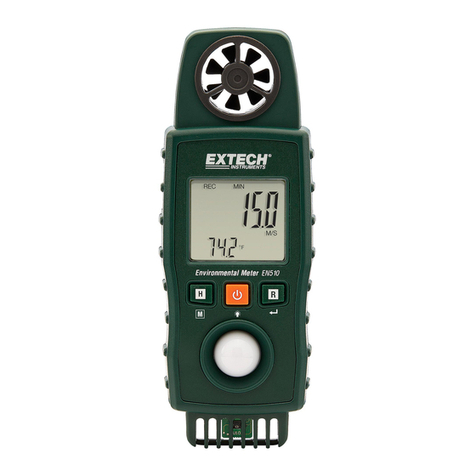
Extech Instruments
Extech Instruments EN510 user manual

ICP DAS USA
ICP DAS USA iWSN-9601 Series quick start
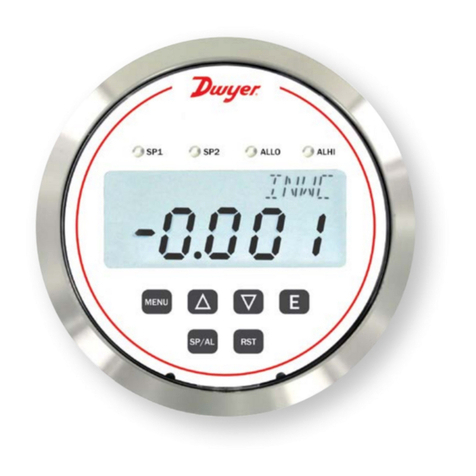
Dwyer Instruments
Dwyer Instruments RPME Series Specifications-installation and operating instructions
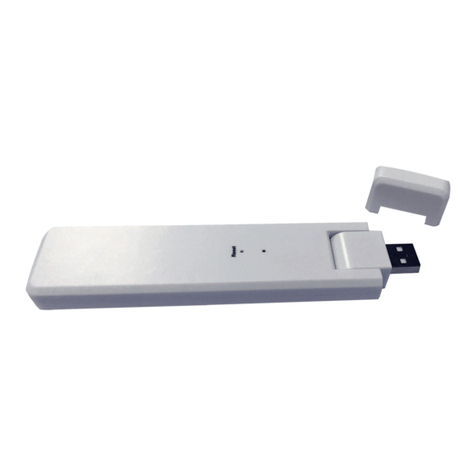
Hoymiles
Hoymiles DTU-W100 user manual
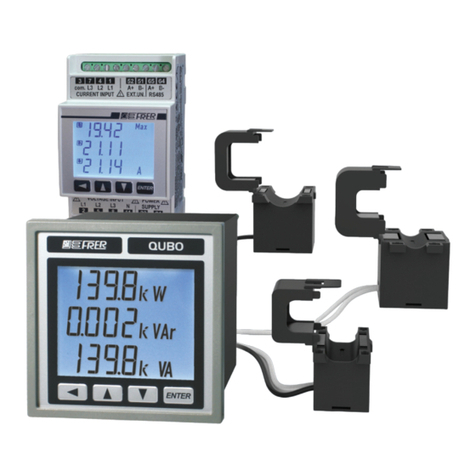
FRER
FRER Q52A3H Series operating manual
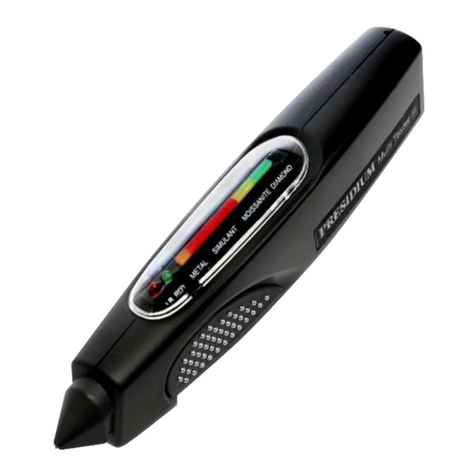
PRESIDIUM
PRESIDIUM Multi-Tester III User handbook
